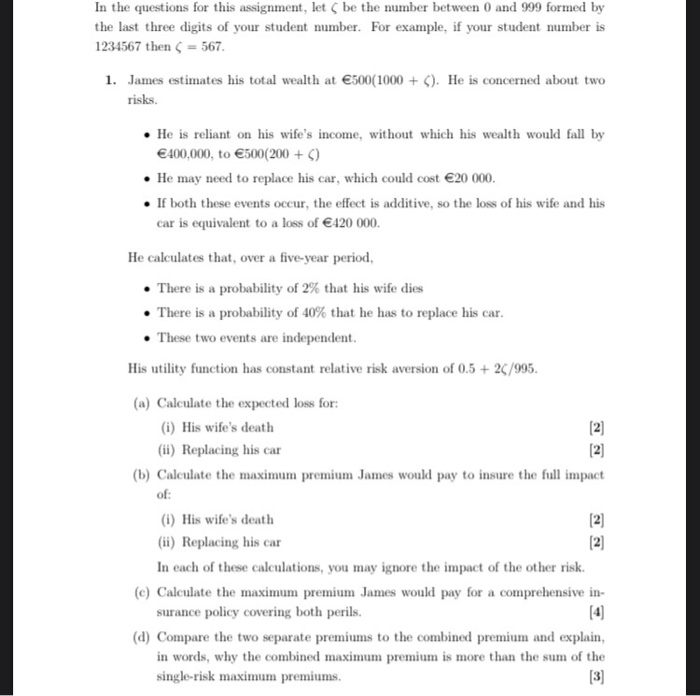
student number is 17414194
In the questions for this assignment, let be the number between 0 and 999 formed by the last three digits of your student number. For example, if your student number is 1234567 then ( = 567 1. James estimates his total wealth at 500(1000 + S). He is concerned about two risks. He is reliant on his wife's income, without which his wealth would fall by 400,000, to 500(200 + ) He may need to replace his car, which could cost 20 000. If both these events occur, the effect is additive, so the loss of his wife and his car is equivalent to a loss of 420 000. He calculates that, over a five-year period, There is a probability of 2% that his wife dies There is a probability of 40% that he has to replace his car. . These two events are independent. His utility function has constant relative risk aversion of 0.5 + 26/995. (a) Calculate the expected loss for: (i) His wife's death [2] (ii) Replacing his car [2] (b) Calculate the maximum premium James would pay to insure the full impact of: (1) His wife's death [2] (ii) Replacing his car [2] In each of these calculations, you may ignore the impact of the other risk. (e) Calculate the maximum premium James would pay for a comprehensive in- surance policy covering both perils. (d) Compare the two separate premiums to the combined premium and explain, in words, why the combined maximum premium is more than the sum of the single-risk maximum premiums. [3] In the questions for this assignment, let be the number between 0 and 999 formed by the last three digits of your student number. For example, if your student number is 1234567 then ( = 567 1. James estimates his total wealth at 500(1000 + S). He is concerned about two risks. He is reliant on his wife's income, without which his wealth would fall by 400,000, to 500(200 + ) He may need to replace his car, which could cost 20 000. If both these events occur, the effect is additive, so the loss of his wife and his car is equivalent to a loss of 420 000. He calculates that, over a five-year period, There is a probability of 2% that his wife dies There is a probability of 40% that he has to replace his car. . These two events are independent. His utility function has constant relative risk aversion of 0.5 + 26/995. (a) Calculate the expected loss for: (i) His wife's death [2] (ii) Replacing his car [2] (b) Calculate the maximum premium James would pay to insure the full impact of: (1) His wife's death [2] (ii) Replacing his car [2] In each of these calculations, you may ignore the impact of the other risk. (e) Calculate the maximum premium James would pay for a comprehensive in- surance policy covering both perils. (d) Compare the two separate premiums to the combined premium and explain, in words, why the combined maximum premium is more than the sum of the single-risk maximum premiums. [3]
 student number is 17414194
student number is 17414194





